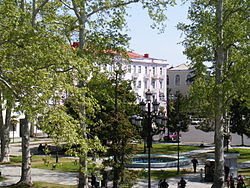Osurgeti
|
Osurgeti ოზურგეთი |
||
| State : |
|
|
| Region : | Guria | |
| Municipality : | Osurgeti | |
| Coordinates : | 41 ° 56 ′ N , 41 ° 59 ′ E | |
| Residents : | 14,785 (2014) | |
| Time zone : | Georgian Time (UTC + 4) | |
| Community type: | city | |
|
|
||
Osurgeti ( Georgian ოზურგეთი ) is a city in Georgia . The administrative center of the Guria region and the municipality of the same name has 14,785 inhabitants (as of 2014). It is crossed by the Natanebi and Budschudschi rivers. The asteroid (2139) Makharadze was named after the old name of the city.
history
The city of Osurgeti was founded in medieval Georgia. In the Russian Empire it was initially the residence of the Prince of Guria and then the district town in the Kutais Governorate. In 1840 Osurgeti received city rights. During the Crimean War , General Iwane Andronikashvili defeated 30,000 men of the Turkish main corps at Osurgeti on June 16, 1854, thereby securing Mingrelia for Russia. From 1934 to 1989 the city had the surname of the Georgian Communist Party leader of the 1920s and 1930s, Philipp Macharadze. It now bears its original name again. Since 1995 Osurgeti has been the capital of the Guria administrative region and the Osurgetia district.
economy
The city's largest employers are a tea, canning and reinforced concrete factory. The city is the end point of a daily railway line via Samtredia to Tbilisi .
Attractions
The city center is formed by a Georgian Orthodox Church, a city theater and a park. In the square in front of the theater there is a bust in memory of the Soviet dictator and native Georgian Josef Stalin . A museum is dedicated to local history.
Twin cities
Ozurgeti maintains the following cities a twinning :
-
 Henichesk (Ukraine)
Henichesk (Ukraine)
sons and daughters of the town
- Giorgi Kekelidze (* 1984), Georgian poet and essayist
- Manuchar K Wirkwelia (* 1978), wrestler and Olympic champion
- Valery Qasaishvili (* 1993), football player
- Vladimir Nemirowitsch-Danchenko (1858–1943), Russian dramaturge and theater director


